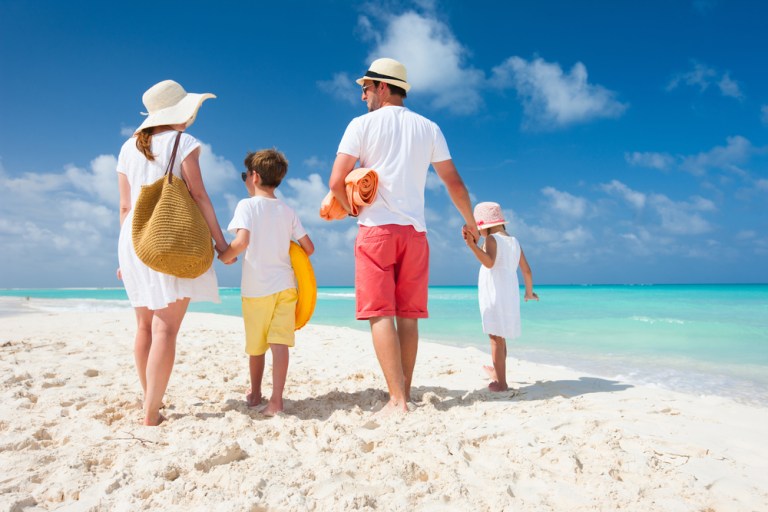
Memorial Day weekend is almost upon us, and with it comes the unofficial start of summer. Sure, the solstice isn’t technically for another month or so, some primary school students are still staring down the clock for another few weeks and there are still many, many graduation parties left to attend this season.
But then again, the weather is warm, sandals have replaced rubber boots and from sea to shining sea, Americans will be celebrating soldiers by grilling burgers on their back porch. And after the long and seemingly endless winter that most of the nation just suffered through, declaring summer’s start as early as possible feels like the right move to make in 2018.
Because with summer comes the opportunity to finally think about one of life’s more pleasant topics: going on vacation.
A majority of Americans will be taking off this summer for a trip of some kind, though how big a majority depends on the source – and what exactly counts as a vacation.
As it turns out, there are very few simple answers when it comes to American vacations. In many cases, the data depends on who one asks, or who one asks about.
To Vacation, or Not to Vacation (And What Is a Vacation?)
For example, while Bankrate and Generali Global Assistance’s travel insurance agree that a majority of Americans will be heading out on a summer vacation of some sort this year, although they disagree on just how big a majority that is. Bankrate says about 51 percent of consumers will be hitting the highways and byways this summer, while Generali forecasts that 68 percent of consumers will be heading out.
Moreover, Generali’s data indicates that vacation rates have grown a lot year over year, up 7 percent since 2017 – and that the upswing is a sign of consumers’ expanded economic health.
“Summer travel has rebounded nicely over the past two years as an improved labor market, wage growth and tax cuts have all led to increased consumer confidence,” said Chris Carnicelli, CEO of Generali Global Assistance. “While budgets have remained relatively flat, these positive economic factors have led to an increase in consumers’ discretionary purchasing power, affording more Americans the ability to take summer vacations this year.”
Bankrate’s data, on the other hand, showed mostly flat growth year-on-year between 2017 and 2018. Cost was named as the leading reason for the slow growth, followed by an inability to get enough time off from work or enough freedom from other personal responsibilities.
“One in four Americans does not have any emergency savings,” said Greg McBride, CFA of Bankrate, adding that unemployment is low and wages are finally starting to rise, but consumers hit hard by the recession and slow recovery are mostly not thinking about planning trips.
“People are still living paycheck to paycheck,” McBride noted.
Some of the disagreement in figures, Lissa Poirot, executive editor of Family Vacation Critic told Al Jazeera, is a question of definition – the term “vacation” is rather flexible and can described a variety of travel modes.
“There are options at every price point, from campgrounds to luxury,” Poirot noted, adding that a lot of what gets missed in tabulations of “vacation rates” are shorter weekend trips that are more in line with the “notion of what the ’50s and ’60s were like — the great American road trip, to the national parks and the beach.”
What counts as a vacation, she noted, is often in the eye of the traveler.
And travelers are a varied group, even in the same demographic.
Millennials: The Most, And Least, Vacation-Enthused Generation
Though the reporting for years has been that millennials are killing commerce because they prefer to spend on experiences rather than items, the demographic picture when it comes to millennial travelers is a bit more complex.
Younger millennials – those younger than 30 and relatively new to the workforce – may prefer to spend on experiences rather than objects, but in reality they don’t have much to spend on either.
According to the Bankrate study, millennials as a demographic are most likely to shrug off this summer’s vacation period, either for reasons of cost or because they don’t have paid time off to cover extensive trips. They also plan to spend the least on vacationing: about $1,000 as opposed to the $2,000+ forecast for other generations.
Looking at other data, however, the picture is a little more complicated. Older millennials, particularly parents, tend to prioritize vacation spend because, per the U.S. Travel Association, three in four parents said they believe that “family vacations create priceless new memories.”
Older, better educated and more affluent millennials are also the demographic planning to expand their vacationing in 2018, according to Travelport. More than half of millennials (56 percent) plan to travel more this summer compared to last year, and one out of three in this category are willing to spend $5,000 or more on their vacations, well above the U.S. average.
Millennials are also the most the adventurous and flexible vacationers, when they do choose to go.
They are the age that demographic most likely to try a home-sharing service like Airbnb, and are also much more likely to try new activities when traveling. According to Generali’s data, some 83 percent of millennials will try a completely new activity on vacation, as opposed to only 67 percent of the general population.
So, what did we learn about our summer vacations?
Americans, as a rule, like to go on them – and the majority look to be on track to do so this summer, though how big a majority depends on whose numbers and definition of a vacation one favors. Once you’re out there, look for millennials, probably older ones, probably with kids, and apparently attempting something adventurous.
E.R. trips in new and exciting places are, in their own way, priceless family memories.
Have a nice Memorial Day, and safe summer travels.